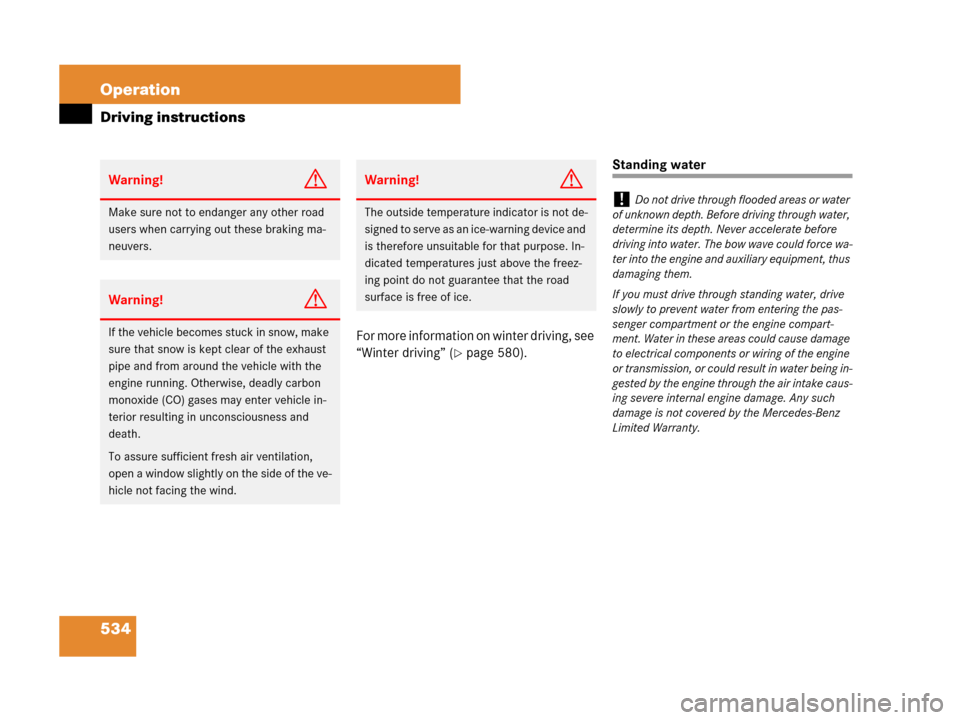Page 42 of 761

41 Safety and Security
Occupant safety
Warning!G
Modifications to or work improperly con-
ducted on restraint systems (such as seat
belts and anchors, emergency tensioning
devices, seat belt force limiters or air bags)
or their wiring, as well as tampering with in-
terconnected electronic systems, can lead
to the restraint systems no longer function-
ing as intended.
Air bags or emergency tensioning devices,
for example, could deploy inadvertently or
fail to deploy in accidents although the de-
celeration threshold for air bag deployment
is exceeded. Therefore, never modify the re-
straint systems. Do not tamper with elec-
tronic components or their software.
Warning!G
In the event that the =indicator lamp
comes on during driving or does not come
on at all, the SRS self-check has detected a
malfunction. For your safety, we strongly
recommend that you contact an authorized
Mercedes-Benz Center immediately to have
the system checked; otherwise the SRS may
not deploy when needed in an accident,
which could result in serious or fatal injury,
or it might deploy unexpectedly and unnec-
essarily which could also result in injury.
In addition, improper work on the SRS cre-
ates a risk of rendering the SRS inoperative
or causing unintended air bag deployment.
Work on the SRS must therefore only be per-
formed by qualified technicians. Contact an
authorized Mercedes-Benz Center.
If it is necessary to modify an air bag system
to accommodate a person with disabilities,
contact your local authorized
Mercedes-Benz Center or call our Customer
Assistance Center at 1-800-FOR-MERCedes
(1-800-367-6372) for details.
Page 45 of 761

44 Safety and Security
Occupant safety
Safety guidelines for the seat belt,
emergency tensioning device and
air bag
Warning!G
�Damaged seat belts or seat belt that
were highly stressed in an accident
must be replaced and their anchoring
points must also be checked. Only use
seat belts installed or supplied by an au-
thorized Mercedes-Benz Center.
�Air bags and pyrotechnic emergency
tensioning devices (ETDs) are designed
to function on a one-time-only basis. An
air bag or ETD that is deployed must be
replaced. PRE-SAFE
® has electrically
operated reversible pre-tensioners in
addition to the pyrotechnic ETDs.
�Do not pass seat belt over sharp edges.
They could tear.
�Do not make any modification that could
change the effectiveness of the seat
belts.
�Do not bleach or dye seat belts as this
may severely weaken them. In a crash
they may not be able to provide ade-
quate protection.
�No modifications of any kind may be
made to any components or wiring of
the SRS. This includes changing or re-
moving any component or part of the
SRS, the installation of additional trim
material, badges, etc. over the steering
wheel hub, front passenger front air bag
cover, outboard sides of the seat back-
rests, door trim panels, or door frame
trims, and installation of additional
electrical/electronic equipment on or
near SRS components and wiring. Keep
area between air bags and occupants
free from objects (e.g. packages, purs-
es, umbrellas, etc.).
�Do not hang items such as coat hangers
from the coat hooks or handles over the
door. These items may turn into projec-
tiles and cause head and other injuries
when the window curtain air bag is
deployed.
�Air bag system components will be hot
after an air bag has inflated. Do not
touch.
�Never place your feet on the instrument
panel, dashboard, or on the seat. Always
keep both feet on the floor in front of the
seat.
�In addition, improper repair work on the
SRS creates a risk of rendering the SRS
inoperative or causing unintended air
bag deployment. Work on the SRS must
therefore only be performed by qualified
technicians. Contact an authorized
Mercedes-Benz Center.
�For your protection and the protection
of others, when scrapping the air bag
unit or emergency tensioning device,
our safety instructions must be fol-
lowed. These instructions are available
from any authorized Mercedes-Benz
Center.
Page 535 of 761

534 Operation
Driving instructions
For more information on winter driving, see
“Winter driving” (
�page 580).
Standing water
Warning!G
Make sure not to endanger any other road
users when carrying out these braking ma-
neuvers.
Warning!G
If the vehicle becomes stuck in snow, make
sure that snow is kept clear of the exhaust
pipe and from around the vehicle with the
engine running. Otherwise, deadly carbon
monoxide (CO) gases may enter vehicle in-
terior resulting in unconsciousness and
death.
To assure sufficient fresh air ventilation,
open a window slightly on the side of the ve-
hicle not facing the wind.
Warning!G
The outside temperature indicator is not de-
signed to serve as an ice-warning device and
is therefore unsuitable for that purpose. In-
dicated temperatures just above the freez-
ing point do not guarantee that the road
surface is free of ice.!Do not drive through flooded areas or water
of unknown depth. Before driving through water,
determine its depth. Never accelerate before
driving into water. The bow wave could force wa-
ter into the engine and auxiliary equipment, thus
damaging them.
If you must drive through standing water, drive
slowly to prevent water from entering the pas-
senger compartment or the engine compart-
ment. Water in these areas could cause damage
to electrical components or wiring of the engine
or transmission, or could result in water being in-
gested by the engine through the air intake caus-
ing severe internal engine damage. Any such
damage is not covered by the Mercedes-Benz
Limited Warranty.